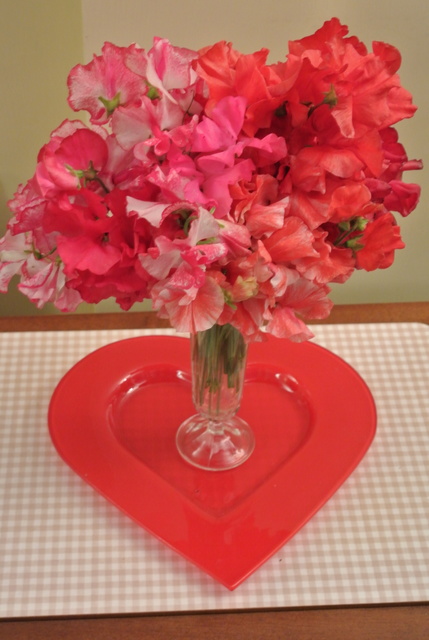A marvellously colourful August for the 3rd year in succession
Monday, August 26, 2013
August can sometimes be a capricious month, promising much yet
failing to deliver. To some extent how the garden looks in August
depends on careful selection of late flowering plants but mostly it
is influenced by the weather. In the last 3 years it
has been the best month of the summer. Although the weather this
year was hot throughout July many plants just seem to have held
back and decided to wait for the rain to come before getting into
flowering mood - the total opposite to2012. Then they held back
because of a lack of sunshine. The result has however been the
same.
The Paddock Borders in all their colourful
slendour
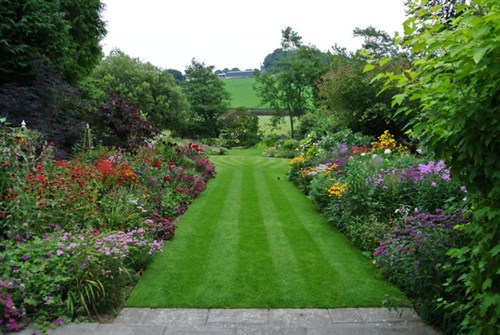
The core border plants which have the greatest impact because of
their size and bold colours, dahlias, lilies and daylilies to name
but a few, just refused to get going but when they did there
was no stopping them transforming the borders in every area of the
gardens. I can scarcely recall them looking better which was great
for all our visitors and especially for us as we had substantially
added plants to many areas of the gardens during spring and early
summer. This is one of those News Items when there is so much to
tell you about it is difficult to know where to begin. On the basis
that "a picture is worth a thousand words" here is a flavour of the
gardens in August.
Dahlias "Wittemans Best" the red one in the
foreground and "Karma Choc" the almost black one with similarly
dark foliage

Late flowering large leaved agapanthus around the Koi
Pond revelling in the late summer sunshine.

A touch of the tropics in mid Wales. Abyssinian red
banana which has grown huge planted in the border soil

A view across the North Facing Paddock Border with
hydrangea arborescens "Annabelle" in the foreground picking up the
shape of the clipped yew at the back. Pure chance like many of the
best things in gardening.
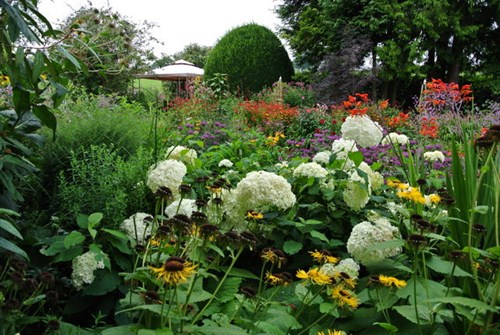
In a quiet corner of the garden a bridge leads across
the stream to the woodland garden, a lovely contrast to all the
colour elsewhere. Note too the fine stand of hosta "Frances
Williams" still looking perfect in late August.
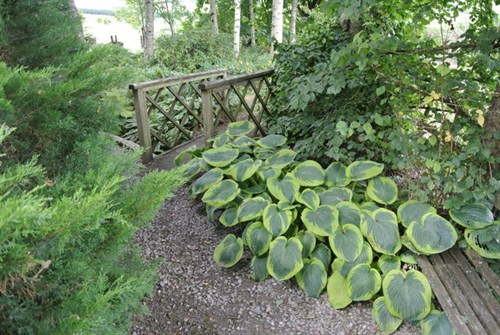
Rosa "Lolabelle" a fine bush form with good bicoloured flowers
and disease free bronze coloured foliage
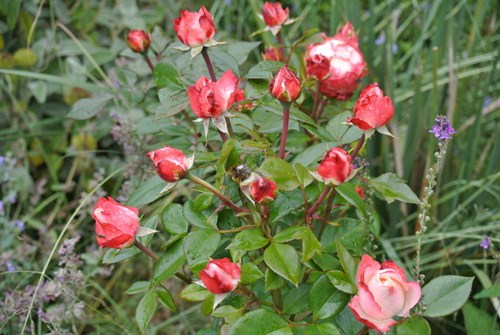
A dainty clematis specie addisonii from the southern
states of the USA but hardy here. Flowers about half an inch or
so.
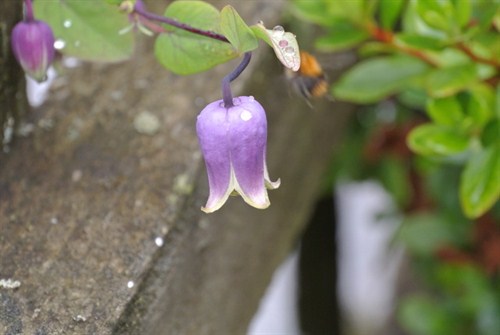
Weather
A good mix of weather from warmth and sunshine to heavy rain at
times but unlike last August, hardly any wind. As a consequence
little watering to do apart from tunnels, nursery and greenhouses -
thank goodness!! Max 25C on 22 August and a min of just 6C on 25th.
For most of the month it was warm day and night but when it rained,
it rained!!
Garden update
Vegetables have been fantastically successful and all the
disappointments of last year have been forgotten as we have been
deluged by over 20 types of vegetables during the month. Although
too numerous to list separately those that have given greatest
satisfaction are peas "Hurst Green Shaft"(none last year) carrots
"Early Nantes2" (ravaged by carrot fly and the weather last year),
beetroot a superb crop of evenly sized roots from a variety
called Monica, a monogerm type from D T Brown and a wide choice of
brassicas untroubled by clubroot and rabbits. Cabbage Primo 2
a long established cultivar and personal favourite, stood for
at least 6 weeks throughout the hot weather and most of
August without splitting or bolting, with good tight heads
for cooking and excellent too for coleslaw. Highly recommended.
Given that the potatoes were planted late by my standards and the
dry weather in July, the crop has been good with only late blight
in the last week or so. Fine quality and superlative taste from
"Exquisa" and the usual reliability from "Charlotte" which stores
well and in fact tastes better the longer it is kept.
Buried treasure - a good crop of Exquisa potatoes which
were only planted in the middle of May

Finally if you grow corgettes or runner beans you don't need me
to tell you about the crops these are producing, especially as my
runners have all come at once, something I desperately try tlo
avoid, but the weather played havoc with my usual sowing
regimes
3 varieties of runner bean "Enorma", "Polestar"
and the best "White Lady" with bigger crops and juicier
pods
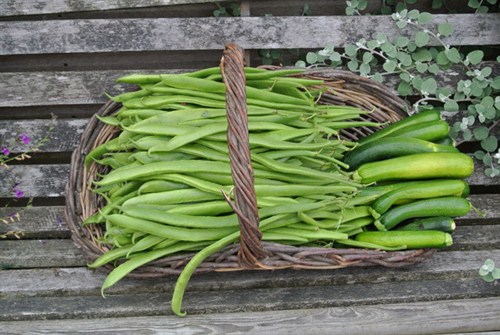
Water liles have revelled in the sunshine and warm water and
flowered prolifically. The Canadian pond weed has gone crazy and I
have had to "weed" the Paddock Pond on a regular basis as I like to
have some clear water to provide reflection of the pondside
planting and to see more clearly the shoals of rudd and all their
offspring.


Our lovely lawns have struggled a bit in spite of irrigation,
because of a plague of red thread, a fungal disease which although
rarely fatal to grass, leaves superficial brown patches all
over the lawns It thrives in hot weather and heavy early morning
dew.
In spite of the fine qualities of all the other areas of the
garden the mixed/ herbaceous borders are the stars of the show and
the most obvious attractions for our visitors. They are more packed
with plants than ever before and augmented by a range of late
flowering annuals such as cosmos and rudbeckias which are revelling
in the late summer heat. Bedded out tender and half hardy
perennials particularly salvias which come into flower as the day
length shortens, raise the colour and interest levels still
further, all of these flowering until the first frosts. They are
easily propogated now for next year from semi ripe cuttings, if
only you can find the time!!
Salvia corrugata a ssub shrub to 4 feet with briiliant
blue flowers all summer much appreciated by bumble
bees.
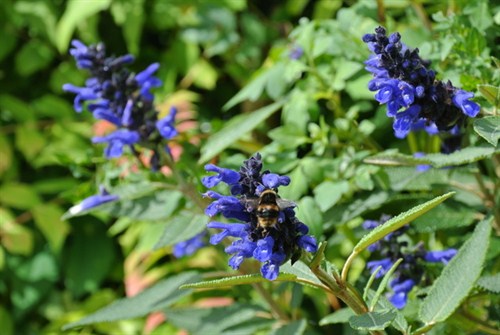
What's looking good?
A visitor to Great Dixter once asked the owner, the late
lamented Christopher Lloyd what was his favourite plant, In the
laconic way of his he replied that it was the plant he happened to
be looking at.
I feel the same way which is why it is difficult to choose the
stars of this month from a firmament filled with them but
here are some of the current best.
So much it's difficult to know where to begin. What I can be
certain of is that until the daylilies, dahlias and late lilies
bloomed the borders seemed less vibrant, and the Red Border in
particular less red than it should have been. Thanks to great big
in your face dahlias like " Witteman's Best" and "Summer Night" all
that has changed. In the same border there are numerou plantings of
7 feet tall lilium speciosum "Black Beauty" totally hardy and much
more vigorous in the ground than in a pot. Daylilies "Scalet Oak",
"Ed Murray" a really dark red and "Night Beacon" all raise
the temperature together with the excellent red annual rudbeckia
"Cherry Brandy".
At 7 feet tall this impressive lilium speciosum "Black
Beauty"
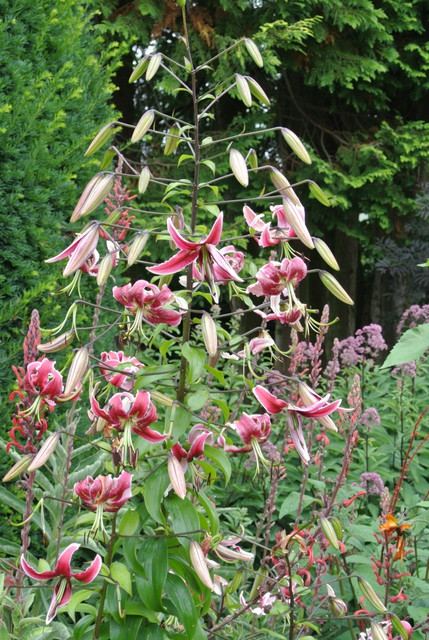
If you grow daylilies never lose the label! This unknown
varietyis a delicate shade of lemon with a lime green eye with a
particularly long season of flowering.
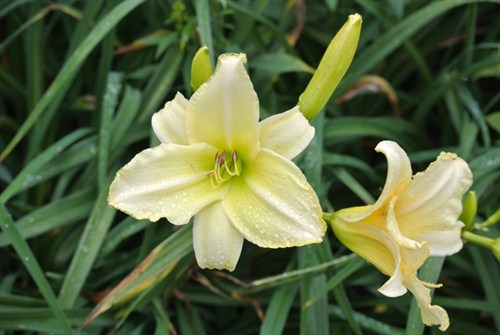
Elsewhere crocosmias in a wide variety are coming to their peak
with the dark leaved and golden orange flowered "Gerbe d'Or"
catching the attention of many visitors alongside a yellow
form "George Davidson" which flowers prolifically even though some
of the clumps are congested and probably need splitting. In the red
border a more upright and less invasive form and better red than
the ubiquitous "Lucifer"is "Emberglow" with a long season of
flowering.
Crocosmia "Emberglow"

In spite of the obvious attractions of perennials I use annuals
freely throughout the gardens, the best of which like rudbeckias
and cosmos reach their peak in late August. At the entrance to the
gardens I have planted a large block of tall flowering cosmos in
shades of pink and white to 5 feet tall (don't always trust
the seed packets as to eventual height!) and was very pleased to
see tha same approach adopted at Aberglasney Gardens on a visit
there last week.
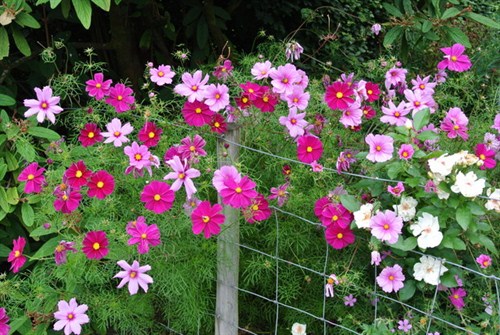
I have also in some areas of the gardens sought to introduce a
more relaxed planting regime to the borders a good example being
the Park Border on the western boundary of Cilgwyn Lodge. In full
sun and well drained soil the large drifts of less varied planted
have created a different colour palate which makes a welcome change
from the one I usually adopt
Agastache rugosa, crocosmias "Star of the East" and
"George Davison", achillea ptarmica, nicotiana alata, poppies and
cornflowers.

At the end of this border is perhaps my favourite part of the
garden at the moment because I so rarely achieve it. I planted a
small block of zinnias as I do every year more in hope than
expectation because they need rather more warmth and sunshine than
we usually have here in West Wales. This year however they
have gone crazy and reached their full potential. Sumptuous
glorious flowers - hope I don't have to wait too long for another
show like this.
Zinnias! They look much better than this in the
garden.

Hydrangeas are great shrubs for late summer with a wide range of
cultivars to choose from. The problem is that in a frost pocket
garden like ours where frost in late May/early June is not unknown,
many of the mop headed and lacecap macrophyllas and to a lesser
extent the serratas, get frosted so we have no flowers later
in the year. The answer is to grow a good selection of forms
that flower reliably on new wood (arborescens like
"Annabelle" but particularly the paniculatas). The size of the
flowers and ultimate height of the plant is governed by the pruning
regime. They can be hard pruned back to one or two buds when the
plant will be shorter but the flowering stems much larger, or
gently pruned just below last years flower when the plant will be
taller but the flowers smaller. I prefer the latter regime firstly
to get more height in the borders where they grow and secondly less
floppy flowerheads. The only downside is that the flowers are
usually in white or cream shades but most paniculatas turn to
various shades of pink or red as they age.
The best ones I have found are "Vanille Fraise" with long
pointed panicles of flowers that age to a lovely soft pink, and
"Magical Fire" whose late colour show is of a deeper shade of red.
A variety called "Phantom" has very large full flowerheads ,
whereas "Kyushu" has a more lacecap effect. Hardy everywhere and
lovely additions to any garden.
"Vanille Fraise"

And the same plant on the middle right of of a mixed
border
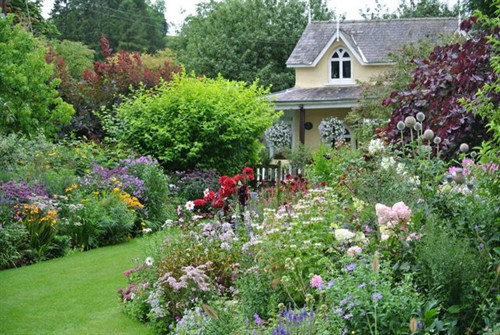
Wildlife and Countryside
The fields are green again after looking very brown in July and
it will soon be "tupping" time of year when the rams return to
start the lamb production process once again. How quickly the year
goes around! Thoughts too turn to cutting firewood for the winter
as the day length shortens and the dew is thick on the ground every
morning. With the the approach of autumn comes the annual bounty of
funghi particularly edible field mushrooms which hopefully after
the heat and rain should be making an appearance soon. In the
meantime we have a fantastic show just over the garden gate where 2
giant puffballs appeared in just a few days. Larger than a football
they make an impressive sight and although edible in the early
stages I am too much of a whimp to try them consoling myself that
when they get to this size they are past their best and
unpalatable. In a week or so the spores will form and they will
deflate as quickly as a punctured football.
Look at the size of them alongside a garden trowel for
comparison.
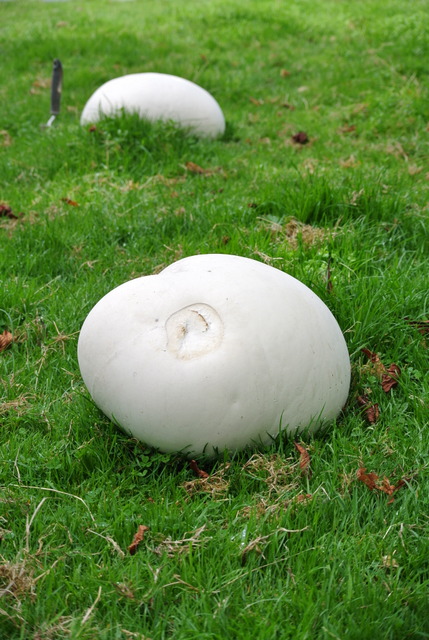
Whilst the warm sunny days remain the vast insect population
continues to enjoy them to the full. Honey bees in good numbers at
last particularly on the emerging sedum flowers are still
outnumbered as they have been all summer, by a wide range of bumble
bees. Wasps are troublesome as always at this time of year. We are
used to disposing of wasps nests in hot summers like this one, but
a couple of weeks ago we became aware of wasps setting up a colony
in the eaves of the house. No obvious nest but they came and went
without troubling us. Then we started to find huge wasps like
Queens falling from the eaves in a comatose state. I have a
gardening friend Julian who is an authority on insect behaviour and
as usual he was able to supple the answer. To save time repeating
it here please visit his Gallery dated 16 August on his
wonderful website at www.thegardenimpressionists.wordpress.com
The highlight of all the insect visitors notwithstanding
some impressive large dragonflies is the number of butterflies. Not
a huge variety and too many Large and Small Cabbage Whites for my
liking, but Peacocks are the most numerous closely followed by
Tortoishells and Red Admirals. A few Commas and Small Gatekeepers
but not enough Painted Ladies, continental cousins that only
come here in a good summer. Favourite plants for all of them are
inula hookerii with big open, upright flowers, and agastache rugosa
with spikes of blue which is always plastered in the largest number
of insects; both plants are an obvious choice for those wishing to
attract insects into the garden.
A red dragonfly just emerging from the larval
stage
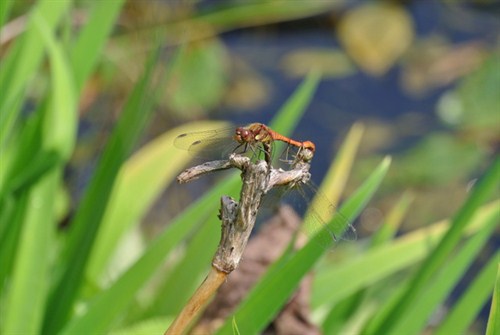
A Comma butterfly samples the first flower of nova
angliae "September Ruby"
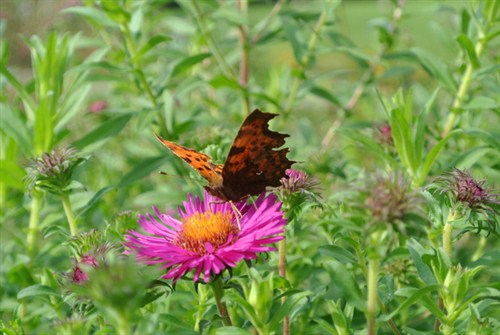
Inula hookerii - the butterfly restaurant!

Much of the bird life is seen around the Paddock Pond and river
with Grey Wagtails common and the fascinating Dipper regularly
seen. The Dipper never strays far from the water often "swimming"
briefly under the water in search of insects which are its main
prey. It is easily identified by its chubby build, black and white
plumage and constant bobbing up and down which gives it the name of
Dipper. Kingfishers are much in evidence too as seems to be the
case at this time of year and one day I hope to capture a picture
to prove it!!
Visits and vistors
Visitors have continued in good numbers throughout August and we
have just reached £2,000 for the charities supported by The
National Gardens Scheme. There have been over 350 visitors so far
this year including 6 coaches from mainland Holland and Germany and
we thank them all for their support. We have one more group booked
for mid September plus any late bookings that may come in at short
notice. With so much fine weather we have only had 2 visits in the
rain. We intend to open again in 2014 on behalf of The National
Gardens Scheme for "By Appointment" visits from June to September.
Groups up to 50 can be accommodated in the Gardens but we can only
provide teas for groups not exceeding 16 people. Teas can however
be arranged for larger groups in Myddfai Visitor Centre and
Community Hall just 2 miles from the gardens.
In between visits this month we have had several of our own to
Shropshire for Wollerton Old Hall and Derwen Garden Centre, the
retail outlet of Dingle Nurseries, the largest in Wales with a huge
range of stock at very competitive prices. to Stockton Bury Gardens
near Leominster one of of our all time favourite gardens and nearer
to home Aberglasney, our nearest public garden.
A quiet corner of Stocton Bury
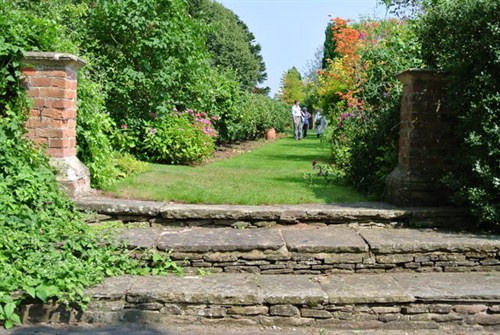
We hope to squeeze in just a few more garden, nursery and plant
fair visits during September. Well you just have to! - we always
need inspiration and yet more plants to improve still further the
Gardens. Happy gardening.
As a thank you for reading all through this long News
item, a little posy of late sweet peas from the garden with our
love!! Moira has adored these red shades all summer, which
perfectly compelement her colour scheme in the
conservatory.
